IDEX Online Research Holiday Jewelry Sales Forecast 2008: Ho, Ho, Whoa
November 06, 08
For more than a quarter of a century, we’ve been publishing annual holiday retail sales forecasts. While we have tried to be very specific with our predictions, we have always added one caveat: if there was a shock to the system, our forecast was null and void.
This year, there has clearly been a shock to the system. The financial markets have been roiling. Commodities prices have been bouncing. Energy prices have been on a roller-coaster ride. All of the media coverage about these uncertain times has created a wall of worry that has caused shoppers to tighten their purse strings significantly. Many economists are predicting a global recession; it will become a self-fulfilling prophecy if enough people believe it.
The jewelry industry is particularly susceptible to system shocks. For most shoppers, jewelry is a discretionary purchase. In uncertain economic times, discretionary spending is the first to be reined in by consumers.
Our Forecast: Soft Sales
The system has been shocked, and there have been many aftershocks. More aftershocks are likely to come, though they should begin to diminish in intensity, just like aftershocks of an earthquake. In the uncertain environment that inevitably follows a major system shock, it is difficult to make a forecast with a high degree of confidence. Thus, our jewelry sales forecast has an element of uncertainty to it.
Our forecast calls for jewelry sales in the all-important November-December period – when U.S. jewelers generate just under one-third of their annual sales – to be down by 3-4 percent, with the possibility of a two-point swing in either direction.

Source: IDEX Online
Forecast Highlights
Highlights in this year’s holiday sales forecast include the following:
- When the final numbers are reported, weak fundamental demand for jewelry will be offset by inflationary retail prices for jewelry as well as easy comparisons against last year’s very weak December results.
- Individual jewelers are likely to show unusually volatile holiday sales results during this period of uncertainty and instability.
- Successful jewelers have embraced the adage: differentiate or die. Their promotions and their merchandise differentiate them from competitors.
- The post-holiday period – especially January – is becoming a more important selling period for jewelers while December is diminishing in importance.
- This year, look for heavier spending from young consumers: they don’t own homes or stocks.
- It’s not the end of the world. Jewelers’ holiday sales will be about 96 percent of last year’s levels. Consumers will shop; forecasts for the total retail segment (all product categories) call for an aggregate gain of near 2 percent. Christmas always comes on December 25.
- American consumers are born to spend. In the aftermath of prior system shocks, it took shoppers about six months to get back on track with their spending patterns.
Jewelry Industry Sales Trends Show Slowdown
The U.S. government has published jewelry sales figures through August; the official numbers are still reasonably solid, though we expect some downward revisions in the coming months. But more up-to-date numbers that we receive from a number of independent jewelers indicate that conditions have deteriorated significantly in the past couple of months. If these jewelers’ sales trends are an indication of total industry sales trends (and we think they are), September will reflect a modest sales decline, followed by even weaker sales in October.
The only factor that is helping to boost sales comparisons is jewelry price inflation at the retail level. Through the first three calendar quarters, retail jewelry prices in the U.S. market were up 6.9 percent, a level we haven’t seen in nearly two decades.
Here’s what the inflation number – +7 percent or so – means: with jewelry sales, as measured by “dollars through the cash register”, up between 2-3 percent so far this year, unit sales of merchandise are actually down between 4-5 percent for the year-to-date.
In addition, percentage sales gains are affected by prior years’ results. Because jewelry sales were down in December 2007 (see graph below), this year’s comparisons (expressed as a percentage of change) are relatively easy against last year’s decline.
In short, the system shock and aftershock uncertainty will hurt fundamental demand, but inflation and easy comparisons to last year will help ease the pain with the final numbers are reported.
2008 Comparisons to Prior Years Not So Bad
The jewelry industry has experienced weak holiday sales in the past. For example, specialty jewelers’ sales were down 5 percent in December 2000, followed by an even steeper decline of over 7 percent a year later in December 2001. In 2000, the economy was weakening, and in 2001, consumers were still recovering from the 9/11 terrorists events. Isn’t the current financial instability and uncertainty worse than either of these events? Consumers react in vastly different ways, depending on the stimuli. This year, older consumers who have much of their net worth tied up in their homes and the stock market will feel less wealthy; they will spend less. Younger consumers, who don’t own homes or stocks, are expected to spend more, according to research.
The graph below summarizes holiday sales trends for the past several years as well as our forecast for 2008 for specialty jewelers.
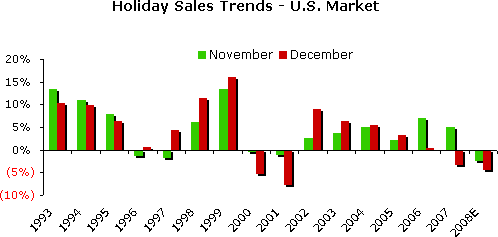
Source: US Dept. of Commerce
Specialty jewelers’ sales represent about half of total jewelry industry sales. It is likely that total jewelry industry sales will not vary notably from specialty jewelers’ sales. Hence, we have shown only specialty jewelers’ sales since they are the most important market segment.
The table below summarizes the figures used to prepare the graph above along with real GDP and jewelry industry inflation for each of the years shown.
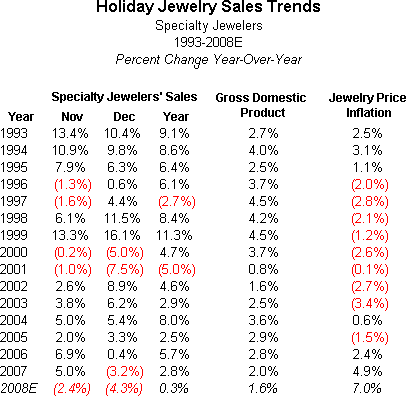
Source: US Dept. of Commerce
Individual Jewelers’ Results Will Vary
While our industry sales forecast calls for disappointing, though not disastrous results, we are seeing unusually wide swings is sales for individual independent jewelers. Some jewelers have reported sales declines of 40 percent year-to-date, while others are reporting sales gains of 40 percent or more. Normally, we would expect to see most jewelers’ sales gains cluster near the industry average. These wider-than-normal sales disparities will continue until conditions stabilize.
What is driving those dramatic sales gains of the highly successful jewelers? What is behind the extremely weak numbers which some merchants are reporting? As we listen to jewelers, certain consistent merchandise trends emerge:
- Successful jewelers are selling the following goods:
- Brands with a high level of consumer recognition
- Custom jewelry
- Colored diamonds
- Estate jewelry
- Designer jewelry
- Fashion jewelry
- Colored precious and semi-precious stone jewelry
- Bridal jewelry
In addition, successful jewelers have differentiated themselves with their promotions, their customer service, and the “look” of their store. They rely heavily on target marketing such as clientelling (phone calls and letters) and direct mail to reach their best customers. They go out of their way to find products that they know their best customers will want to purchase.
- Less successful jewelers continue to rely on these merchandise categories:
- Generic diamond jewelry
- Last year’s unsold merchandise
- Gold jewelry
- “Safe” fashion goods (nothing out of the ordinary)
Don’t Blame Consumer Electronics
We’ve said in the past that consumer electronics gadgets have siphoned off discretionary dollars that could have been spent on jewelry. Why is this occurring? Consumer electronics producers continue to generate a stream of exciting new goods. Apple Computer announced a new line of laptop computers in mid-October during a period when the stock markets worldwide were plummeting. Will those new product introductions sell? Stop in any Apple retail store in the mall: you’ll find it easily, since it is the only one packed with customers.
The problem is that the jewelry industry is not introducing – and promoting – new exciting products.
Hedda Schupak, the well-respected jewelry industry journalist, sums up the dilemma that jewelers face. She says that too many jewelers lie awake at night worrying about the impact of the internet on their business. That may be a waste of time, she suggests. Rather, she advocates that jewelers should be worried about competition from product categories such as scarves, eyeglasses, sunglasses, shoes, cosmetics, handbags, and accessories. We agree with her assessment.
What Can Individual Specialty Jewelers Expect?
So far, all of the numbers in our forecast relate to aggregate jewelry industry sales. What do these numbers mean to an independent specialty jeweler?
There are roughly 29,000 specialty jewelry stores in the U.S. The Jewelers Board of Trade (JBT) census shows 22,700 jewelers, but chains are counted only once by JBT, irrespective of the number of stores they operate. According to the Jewelers of America Cost of Doing Business Survey, the typical American independent specialty jeweler generates sales of about $1.0-1.1 million annually.
Based on our forecast, the typical American independent specialty jeweler is expected to post sales of $308,000 during this year’s November-December holiday sales period, down just under 4 percent from last year’s $320,000 sales level during the same two-month period. Said another way, the typical independent specialty jeweler will generate sales at about 96 percent of last year’s level. It depends on how you look at the glass: half full or half empty.
For the full year, independent specialty jewelers are expected to post 2008 sales that are about flat – just under $1.01million – versus 2007 annual sales.
The table below illustrates these comparisons.
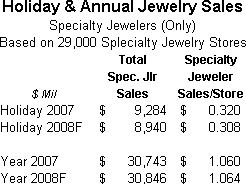
Source: US Dept. of Commerce
Are these numbers disappointing? Certainly. Are they disastrous? Certainly not!
National Retail Forecasts Show Small Gain
Over the past decade, aggregate retail sales in the U.S. market during the all-important holiday selling season have grown at nearly 4 percent year-over-year. On average, most prognosticators are forecasting that sales in the 2008 holiday selling period of November and December will be up by about half the annual average, or around +2 percent.
The table below summarizes some of the higher profile retail sales forecasts for the U.S. market during the 2008 holiday selling season.
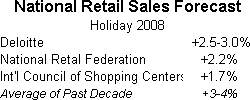
Source: Various
According to holiday sales forecasters, the following items are “hot buttons” which will attract consumers into a merchant’s store:
- Innovative, exciting, new products
- Green products
- Great customer service
- Creative promotions
- Loyalty programs
- Sharp prices
- Value-oriented merchandise
In addition, forecasters noted that younger consumers are expected to spend more than older consumers. Young shoppers own neither stocks nor homes. However, many of the older consumers – above 45 years old – have much of their wealth tied up in their homes and the stock market, both of which have fallen in value. Thus, they feel less wealthy and are expected to spend less.
Holiday Sales Extend into January
It is important for jewelers and other merchants to recognize that the holiday selling period now stretches into January. The days when a merchant could close his store in early January and head for some warm Caribbean island for a vacation are gone.
The graph below summarizes the diminished importance of December and the increased importance of January for jewelers’ sales. Over the past five years, January has increased notably in importance – from about 5.3 percent of a jeweler’s annual sales in 2004 to 5.8 percent of annual sales this year. On the other hand, December has decreased in importance from nearly 24 percent of annual sales in 2004 and 2005 to just over 20 percent of a jeweler’s annual sales this year. There has been little change in the importance of November.
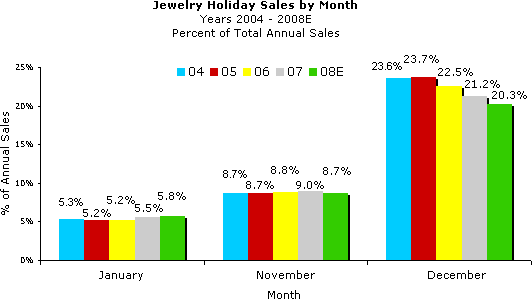
Source: US Dept. of Commerce
The Light At The End of the Tunnel
Several years ago, we completed a study to see how long “system shocks” affected consumers’ spending. We updated that study this year. System shocks differ in intensity, and they differ in the factors that caused them, so it is difficult to make statements which are too general. However, we have found that it takes roughly six months for consumers to return to their former levels of spending, after suffering from a system shock. That’s not good news for the 2008 holiday selling season, but it is good news for 2009.
Holiday Greetings from all of us at IDEX Online!
* * *
Again this year, IDEX Online is offering a Holiday Backgrounder on the jewelry industry. It is available to the media, industry participants, and anyone with an interest in learning more about how the jewelry industry is affected by consumer demand in the all-important holiday selling season. Request your copy at research [at] idexonline [dot] com.